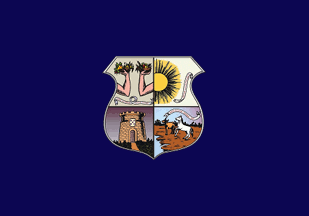 image by Dirk Schönberger,
9 January 2011
image by Dirk Schönberger,
9 January 2011Source: based on http://www.cnm.org.br/municipio/hino_brasao.asp?iIdMun=100115020

Last modified: 2011-02-18 by ian macdonald
Keywords: brazil | pará | belem | coat of arms | donkey | cow | sun | river | cornucopia |
Links: FOTW homepage |
search |
disclaimer and copyright |
write us |
mirrors
 image by Dirk Schönberger,
9 January 2011
image by Dirk Schönberger,
9 January 2011
Source: based on
http://www.cnm.org.br/municipio/hino_brasao.asp?iIdMun=100115020
Other sites:
The flag is the municipal coat of arms on a dark blue field. The colors differ somewhat in other
renderings of the coat of arms, but these are the colors shown in the photograph of the flag
shown at www.belemvivo.com.br. The photo also
shows the quarterings and the shield itself edged in black, while other renderings show the edging in gold.
Joseph McMillan, 7 July 2002
The coat of arms of Belém was created early in the 17th century when the capitão-mor
(military commander) of the Captaincy of Grão-Pará, Bento Maciel Parente, along with Pedro Teixeira,
Ayres Chichorro, and the Baron de Abreu, decided to adopt a coat of arms to place on the Forte do Castelo.
The coat of arms is divided quarterly: